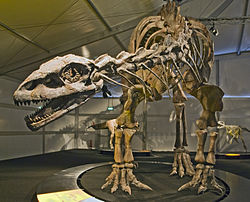| Lessemsaurids | |
|---|---|
 | |
| Skeletal mount of Lessemsaurus | |
| Scientific classification | |
| Domain: | Eukaryota |
| Kingdom: | Animalia |
| Phylum: | Chordata |
| Clade: | Dinosauria |
| Clade: | Saurischia |
| Clade: | † Sauropodomorpha |
| Clade: | † Sauropoda |
| Family: | † Lessemsauridae Apaldetti et al., 2018 |
| Genera | |
| |
Lessemsauridae is a clade (family) [1] of early sauropodiform dinosaurs that lived in the Triassic and Jurassic of Argentina, South Africa and possibly Lesotho. A phylogenetic analysis performed by Apaldetti and colleagues in 2018 recovered a new clade of sauropodiforms uniting Lessemsaurus , Antetonitrus , and Ingentia which they named Lessemsauridae. It is a node-based taxon, defined as all descendants of the most recent common ancestor of Lessemsaurus sauropoides and Antetonitrus ingenipes. [2] Depending on the definition of Sauropoda, Lessemsauridae is either one of the most basal sauropod taxa, or a sister taxon of Sauropoda. An additional member of the clade was named later in 2018, Ledumahadi . [3] A 2021 study by Pol and colleagues also assigned the genera Kholumolumo and Meroktenos to the group. [4]











